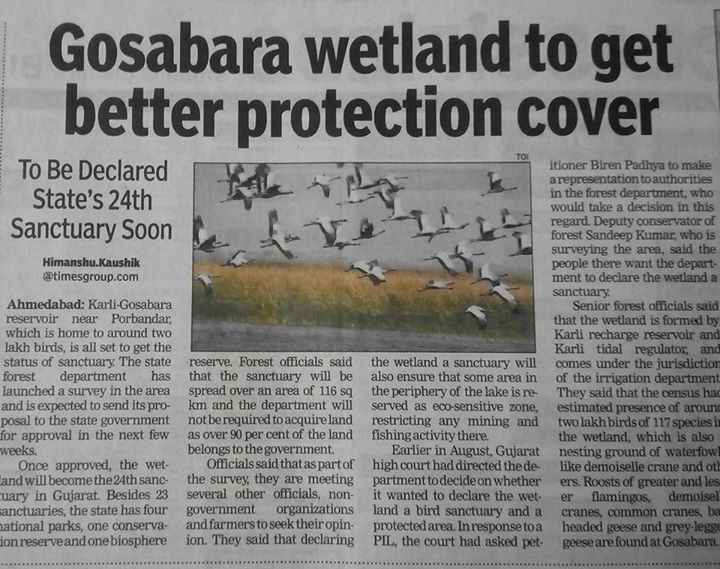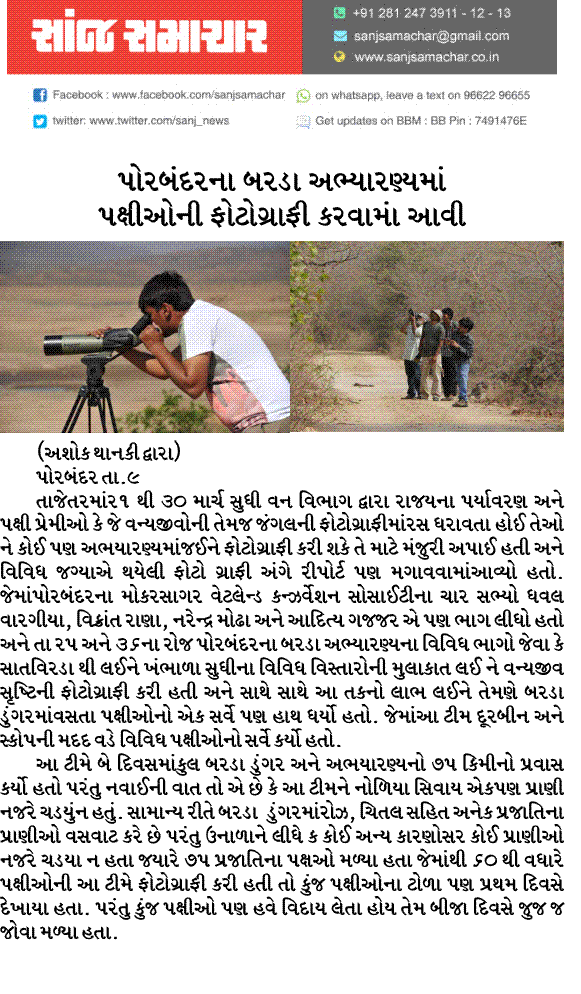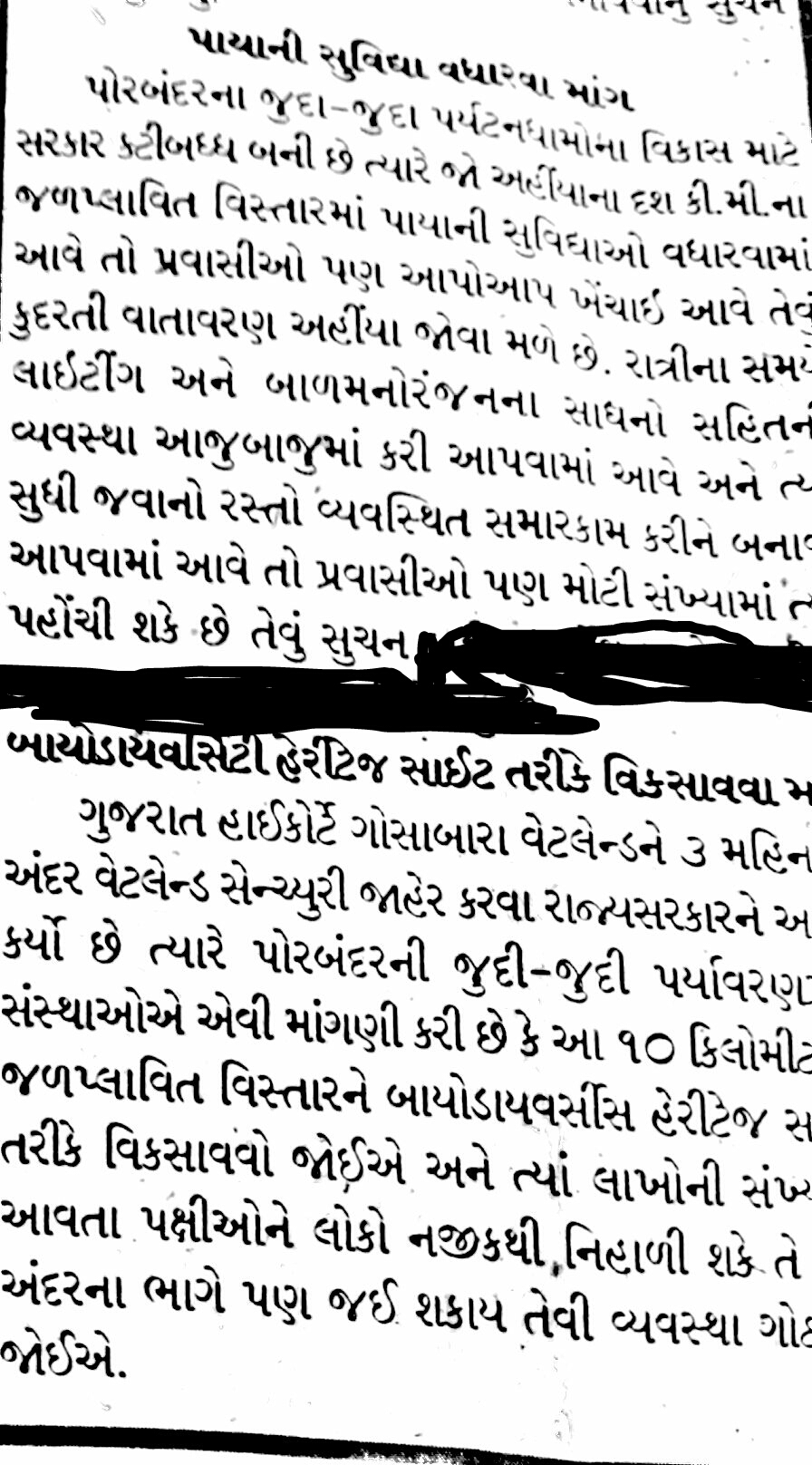Events & Activities
Asian Waterbird Census (AWC) 2015 at Porbandar
Wetland International co-ordinates the AWC. The AWC runs parallel to other International census in Africa, Europe, and Neotropics under the umbrella of the International Waterbird Census (IWC). Every year, AWC is conducted by birdwatchers. As per the National Wetland Atlas of Gujarat, Porbandar has 226 satellite wetlands, out of which the important wetlands were studied during AWC.
Gujarat Council on Science and Technology (GUJCOST), Gandhinagar recognised and Shri
Satsang
Shiksha
Parishad managed, Shree Sahajanand Swami District Community Science Centre (SSDCSC)- Porbandar in the
collaboration with Porbandar Forest Division- Porbandar, Indian Coastguard, Porbandar, Green Wildlife
Conservation Society and Mokarsagar Wetland Conservation Committee organised Asian Waterbird Census
(AWC) on
1st February- 2015.
An introductory seminar was arranged on 31st January- 2015 at SSDCSC in the presence of Dr. Lalit Parmar, Deputy Conservator of Forests, Porbandar Forest Division, Porbandar. The participants were given special kit for AWC. Birds of Northern India (Gujarat Version), Notebook, Pen, Digital bird counter, and certificates were included in the kit. Mr. Dhaval Vargiya, Science Co-ordinator, Shree Sahajanand Swami District Community Science Centre presented a PowerPoint Presentation on “Wetlands of Porbandar” followed by “How to do AWC?”
17 birdwatchers from Jamnagar and Porbandar have participated in AWC. These birdwatchers were grouped in four different teams and were allotted four separate routes and covered 21 sites.
1. Routes of AWC (Porbandar)
1.1.Route 1: (5 sites)
1.1.1. Coastal line (3 sites)1.1.2. Amipur region
1.1.3. Mokarsagar region
1.2.
Route 2: (5 sites)
1.2.1. Kuchhadi1.2.2. Visavada
1.2.3. Mendha creek
1.2.4. Lamba (2 sites)
1.3.
Route 3: (4 sites)
1.3.1. Porbandar Bird Sanctuary1.3.2. Javar
1.3.3. Subhashnagar
1.3.4. Bardasagar
1.4.
Route 4: (7 sites)
1.4.1. Chhaya (3 sites)1.4.2. Karly (2 sites)
1.4.3. Dharampur
1.4.4. Vanana
AWC was conducted by birdwatchers on above mentioned sites and routes on 1st February- 2015. 2nd February-2015 is known as World Wetland Day. Mr. Dhaval Vargiya, Science Co-ordinator and Mr. Viek Bhatt, Science Communicator, Shree Sahajanand Swami District Community Science Centre, visited Shree Madressa Boys School and explained importance of wetland and threats to wetland with PowerPoint presentation on world wetland day i.e. 2nd February-2015.
Team on a particular route was selected on the basis of the talent and expertise of birdwatchers. Due care was taken that each team receives at least one photographer, one expert and one or two assistants. During a day, birds migrate from one wetland to another. So there are chances that a flock of a bird may be counted twice which generates non-reliable data. So, to avoid such problems, all the sites were studies on a single day and all together.
School Programmes
Our educators visit schools regularly, interacting with both students and teachers.For Students:
The educators talks about books, reading, travel, environment, conservation and geography. Dhaval Vargiya presents slideshows on his photography. There are slideshows on the Biodiversity, Birds, Animals, Reptiles, Butterflies, Endangered animals, Threats to Biodiversity. Chirag Tank talks about snakes of Saurashtra, snake bite management and wildlife rescues.
For Teachers:
The Earth's natural ecosystems are being degraded at a rate unprecedented in world history Living (Planet Report – WWF). The world is under severe environmental stress. Dhaval Vargiya – wildlife photographer and photo conservationist – explains the truth of the statement. He provides a unique point of view on the earth's most pressing environmental problems. He also provides insights on India, its landscape, its wildlife, conservation, and how current environmental issues like global warming affect the country.
We believe that teachers must be made aware of the earth's problems, as they are the source of knowledge
for children. A proper understanding of the issues challenging the earth's well-being will help them
communicate the problems better to children. Children must be taught about forests and wildlife. It is
only if they are taught will they love and see a reason to save our natural world.
- GWCS has highly skilled educators who involve people to understand the importance of Biodiversity, threats, birds identification, and snakes of Saurashtra through powerpoint presentation.
- Presentations like
- Biodiversity
- Threats to Biodiversity
- Snakes of Saurashtra
- Snake bite management
- Bird identification workshop
- Wildlife rescue and release
- Importance of ozone
- MoU Signed between GIZ, GEER Foundation and the Gujarat Forest Department
- Pink Celebration 15
- World Wetland Day 15
- Asiatic Lion Landscape Conservation Seminar
- Ecotourism Workshop at Gandhinagar
- Wetland Education
- Doordarshan Broadcasting
- Asian Waterbird Census at Mokarsagar
- Mokarsagar Website Lauched
- Demarcation survey of proposed Sanctuary
- State Expert of CMPA Project
- Sustainable Tourism Study
- Wetland Cleanup
- Golden Jubilee celebration at Sasan
- Dr B C Chaudhary, Scientist, WII
- Wetlands International- S Asia
- Visit to Bombay Natural History Society
Sagar Sangathi
Sagar Sangathi
Pink Celebration 2016
Pink Celebration 2016
Mokarsagar Wildlife Sanctuary?
Locals have proposed the wetland as Sanctuary

Bird`s Photography at Barda Sanctuary.
Bird`s Photography at Barda Sanctuary.

Recreational activities at Mokarsagar
We strongly oppose such activities at Mokarsagar wetland as these may turn a wetland to public spot. Such activities can be further promoted near Rangbai.
